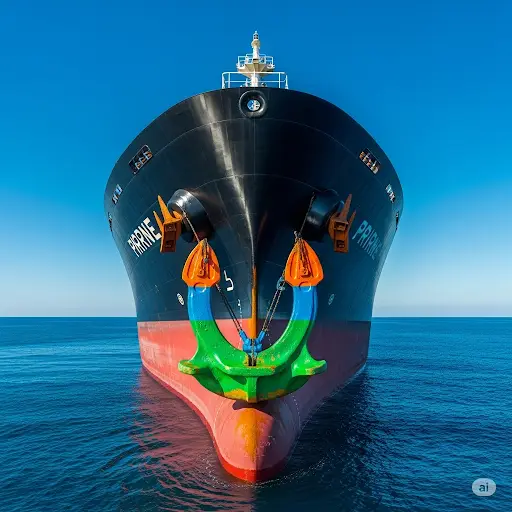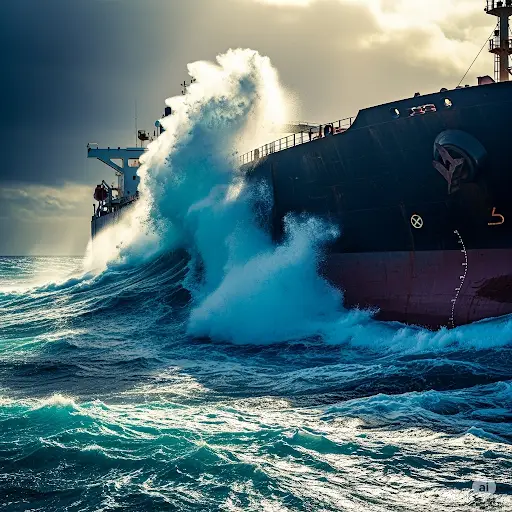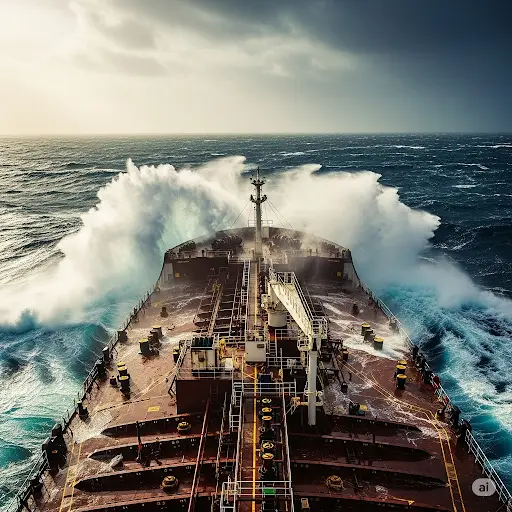The Red Sea’s Permanent Scar: How Escalating Maritime Terror Reshapes Oil’s Global Risk Landscape
The global oil market is often characterized by the ebb and flow of supply and demand, a complex dance of extraction and consumption. Yet, this past week, a more brutal, unpredictable rhythm has taken hold. The Red Sea, a vital artery of global commerce, has become a theatre of escalating terror, its waters bearing witness to lost vessels and lives. As we begin this new week, the market is not merely reacting to events; it is fundamentally recalibrating its understanding of risk, price, and the very security of global energy supply. The scars of the Red Sea are already reshaping the landscape.
As of this Monday afternoon, July 14th, in New York, crude prices reflect this deepening concern, actually rising into the week. Brent Crude is currently trading around $71.39/bbl, and WTI Crude is at $69.51/bbl, marking their highest levels in three weeks. This upward movement is a stark counterpoint to typical market reactions to the 548,000 bpd August supply increase by OPEC+ and last week’s significant 7.1 million barrel build in U.S. crude inventories. The market is clearly prioritizing the immediate and escalating threat to global shipping over traditional supply-side signals.
The Inexorable Rise of Geopolitical Risk
The weekend brought grim clarity to the severity of the Red Sea crisis. New reports today confirm that the search has tragically ended for missing crew from the MV Eternity C, which was sunk by Houthi attacks last week. Maritime security firms involved in the search have indicated that at least four crew members are presumed dead and 11 others remain unaccounted for. This follows the loss of the MV Magic Seas, underscoring a horrifying escalation in the human cost of this maritime conflict.
Furthermore, satellite imagery from Planet Labs PBC analyzed today by The Associated Press shows large, spreading oil slicks from where both the MV Magic Seas and MV Eternity C sank in the southern Red Sea. This raises grave environmental concerns, threatening marine life and protected ecosystems in the region. The Houthis, for their part, continue to claim responsibility, asserting their actions are in solidarity with Palestinians in the Gaza conflict, and warning any vessels with perceived ties to Israel.
This is no longer merely an economic disruption; it’s a rapidly unfolding humanitarian and environmental crisis that directly impacts the flow of global energy. The international community is struggling to respond effectively. The UN Security Council today unanimously extended the mandate of the UN Mission to Support the Hudaydah Agreement (UNMHA) until January 2026, a move that signifies continued international concern but also highlights the ongoing challenges in securing the port city from which many Houthi attacks originate.
Colliding Fundamentals: Supply Push vs. Risk Pull
In a market often driven by simple supply-demand dynamics, the current scenario presents a profound anomaly.
From the supply side, OPEC+ is pressing ahead with its strategy, having committed on July 5th to inject an additional 548,000 bpd into the market for August. This signifies their intent to reclaim market share and meet perceived global demand. Adding to this apparent abundance, last Wednesday’s EIA Weekly Petroleum Status Report confirmed a substantial 7.1 million barrel build in U.S. crude inventories for the week ending July 4th. These are fundamental bearish signals that, in normal times, would send crude prices tumbling.
Yet, prices are not tumbling. Instead, as we’ve seen today, they are rising, with Brent well above $71/bbl and WTI nearing $70/bbl. This stark divergence illustrates the overwhelming power of the Red Sea “risk pull.” The market is effectively pricing in the immediate and escalating threat to global maritime trade, acknowledging that barrels produced are useless if they cannot be safely delivered.
The Structural Shift: A Permanent Risk Premium?
What we are witnessing is more than a temporary “geopolitical risk premium.” It is a fundamental, structural re-pricing of risk for any oil (or goods) that transit through the Red Sea and, by extension, the Suez Canal. This shift is being driven by tangible, immediate factors:
- Soaring Insurance Costs: Marine insurance costs for Red Sea transits have skyrocketed, reportedly more than doubling in recent days. Sources indicate war risk premiums have jumped from approximately 0.3% to as high as 0.7-1.0% of a vessel’s value per voyage. For a typical crude tanker, this translates to hundreds of thousands to over a million dollars per trip, a cost that is passed directly onto the buyer and ultimately, the consumer. Some underwriters are even pausing or withdrawing coverage for certain voyages, creating bottlenecks and forcing rerouting.
- Effective Supply Constraint: The continued rerouting of vessels around the longer, more expensive Cape of Good Hope route is not a preference; it’s a necessity. This adds significant delays (days to weeks) and increases fuel consumption and operational costs, effectively reducing the available supply reaching markets on time. This physical constraint on efficiency cannot be offset by mere production increases.
- EIA’s Validation: The EIA’s recent upward revision of its 2025 Brent crude oil price forecast to $68.89/bbl, explicitly citing “increased geopolitical risk,” serves as critical third-party validation. It confirms that this risk factor is now formally incorporated into the official outlook, indicating a long-term impact on price expectations.
This confluence of factors suggests that the oil market is now operating with a permanent scar from the Red Sea crisis. The cost of chaos has been monetized and built into the price structure.
Redefining Supply Chain Resilience
The Red Sea crisis lays bare the inherent fragility of modern “just-in-time” global supply chains. These systems, designed for maximum efficiency and minimal inventory, buckle under the pressure of prolonged, unpredictable disruption to vital arteries.
Major energy companies and importing nations are now forced into a strategic re-evaluation:
- Diversification: Actively seeking alternative crude sources and refining hubs to reduce reliance on Red Sea transit.
- Inventory Buffers: Reconsidering lower inventory levels, acknowledging the need for larger strategic reserves or commercial stockpiles to cushion against future shocks.
- Route Assessment: A deeper, long-term assessment of the viability and security of traditional shipping routes, with the potential for permanent shifts or a more dynamic routing strategy based on real-time risk.
The Suez Canal’s long-term strategic importance may also be implicitly challenged if security cannot be guaranteed, forcing a fundamental shift in global trade patterns.
The Global Geopolitical Chessboard
The Red Sea crisis is not isolated; it is inextricably linked to the broader geopolitical chessboard of the Middle East. The ongoing conflict in Gaza fuels Houthi actions, and the lack of a comprehensive regional solution means the attacks are likely to persist.
Global powers, including the United States, the European Union (with operations like Aspides), and the United Kingdom, have deployed naval assets to the region. However, the continued attacks and sinkings underscore the immense challenge of fully securing such a vast and complex maritime domain against asymmetric threats. The rising humanitarian and environmental costs also intensify pressure for a more robust and effective international response.
Outlook: A Volatile Path Ahead
There is no quick fix for the Red Sea crisis. Its persistence means that the geopolitical risk premium is unlikely to dissipate soon. This will lead to continued volatility and a higher baseline for oil prices, irrespective of more conventional supply-demand metrics.
Key indicators to watch in the coming weeks include:
- Further marine insurance rate adjustments and any widespread decisions by underwriters to cease coverage.
- The actual number of vessels rerouting around the Cape of Good Hope, which will provide a clearer picture of the effective supply reduction.
- Any shifts in international diplomatic or military posture, potentially indicating a more aggressive approach to deterrence.
- The impact on refined product markets, particularly EN590 diesel and JET A1, where supply chains are often more intricate and vulnerable to shipping disruptions.
Conclusion: The Cost of Chaos
This week begins with the undeniable truth that the cost of chaos is rising. The Red Sea has introduced a permanent, violent scar on the global oil market, fundamentally altering its risk-return profile. For the discerning operative, understanding this structural shift in risk, beyond the headlines, is paramount. The global energy market is now navigating a treacherous new reality, where every barrel carries a geopolitical burden. Stay alert; the intelligence demands it.
Important Note on Volatility:The oil and gas market is experiencing significant volatility. Prices for crude oil, refined products, and associated logistical costs are changing rapidly. The figures quoted above reflect the general market situation as of Monday, July 14, 2025, New York Time. This is a fast-evolving situation, and continuous vigilance and reassessment are paramount.





